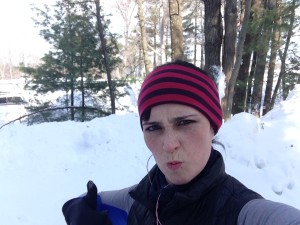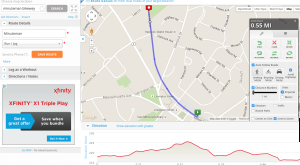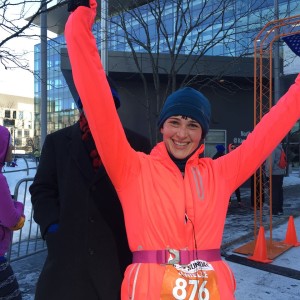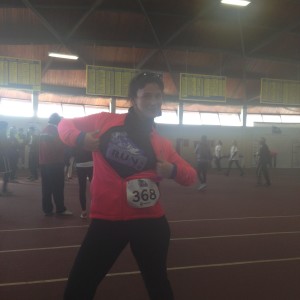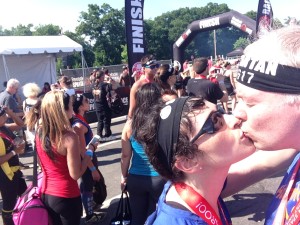I had hoped to get a recap up today of Wipeout, Boston, but I’m still waiting on their official race pics. Because the course was full of water traps, I didn’t manage to snag any on my own (didn’t want to risk bringing my usual photography methods on the course, and my disposable technology got so waterlogged that it failed me). So we’ll have to wait on that for next week; but it’s coming, I promise!
Instead, I want to take a moment to chat about one of my favorite running gear companies: RawThreads athletics.
I first found RawThreads through the Run, Disney! Community. Since I’m training for the Glass Slipper Challenge in 2016, I have a LOT of Run Disney links that have come across my various feeds. After glancing through RawThreads’ designs, I decided that I probably couldn’t live without them and simply had to have a few of their awesome shirts. I’ve since become addicted and now own a wide array of their products from capris to arm warmers. All of them are super cute with colors that pop (black on black running gear has no personality and I try to shy away from it whenever possible).
All of their stuff is made of bamboo blend tech fabric. This means that it’s wicking, anti-microbial, and oh so soft. I’m not a fan of stiff or scratchy fabrics and since tech gear is synthetic by nature so much of it tends to just feel wrong. Not RawThreads; I could seriously sleep in my running gear if I wanted.
I will say that it doesn’t dry very quickly so when the weather turns cold, I will probably shy away from running in it simply because sweaty clothing = cold runner. But that does mean that it’s great for summer runs; it gets moisture away from my skin and keeps me cool at the same time. While I have worked up some pretty unflattering sweat patterns during summer long runs (sorry, no pictures of those), I can’t really bring myself to mind. There’s only so much you can do to look cute after running ten or twelve miles in summer heat.
Their clothing is durable and built to last. I’ve been running hard in it 3-4 times a week for about six months now and it shows nary a sign of wear. Since it’s easy care, it goes right in the washer/drier without fuss or muss. I haven’t seen pilling, tearing, or stretching of any kind, and all of the logos/designs are holding up beautifully. There has been no fading, and all the zippers are doing great.
Oh, did I mention their pants have zippered pockets large enough to fit my cell phone, keys, and gels in? This means that on shorter runs when I don’t need hydration (or if I choose to carry a hand-held), I can go belt/camel-bak/pouch free! They’re great for 5Ks when you just want to have your phone on you; maybe even slightly longer races or training runs depending on how much water you need. I, personally, love them!
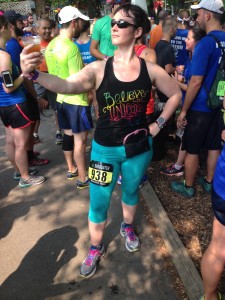
Pretty much RawThreads head to toe in this one: Sprinter Crop in Baltic Dot with Rainbows and Unicorns Racer. Also: Victory beer.
Shipping is fast; the company is located in Kissimmee, Florida and I generally get my orders here in Boston within a week. Pretty good considering how far that little package has to go!
Perhaps the best part about RawThreads is their awesome customer service. Over the past several months, I’ve had two instances in which I dealt with their customer support team. In both instances, I was responded to promptly and appropriately; the folks at RawThreads stand by their products and take great care of their customers.
So far, my favorite RawThreads product is my set of arm warmers. I find most arm warmers to be chafey and stiff, and they kind of make my arms look like sausages. RawThreads arm warmers are the same soft bamboo blend as the rest of their clothing, so they have a bit more give than the conventional polyester without sacrificing hold (trust me, they stay up). They are nice and warm, but not oppressive. Since they do have a bit more space, they’re also easy to roll down when you’re too hot; they just collapse onto your wrists and you have a stylish running bracer.
Another favorite of mine, and one I wear almost every day when I run in the summer, is the RawThreads racer. I have several in different colors and designs so that I can rotate through them over the course of my training. Not only are they super fun between colors and logos (athletic gear can get really boring sometimes, right?), they’re also breathable and roomy. They have a bit more room in them than most standard athletic wear so they’re a bit more forgiving on days when you don’t want a next-to-skin fit. This combined with the longer length means that they don’t ride up during your run (even when wearing them in combination with a belt), which in turn means no chafing for you! The sizing on these clothes is true to the website-provided size charts; since it’s athletic clothing, it’s a bit smaller than conventional street sizes. While I’ll wear a Small or Medium generally in women’s tops, RawThreads Large is my go-to size. Measure carefully, consult the size chart, and you’ll be alright.
As you can tell, I highly recommend splurging on some RawThreads gear. Not only is it comfortable, but also functional and durable. Basically everything you want out of your running gear.
Please note that I have received no compensation, monetary or otherwise, for this post from RawThreads or anyone else.

